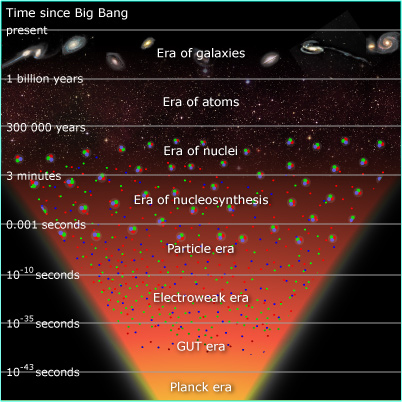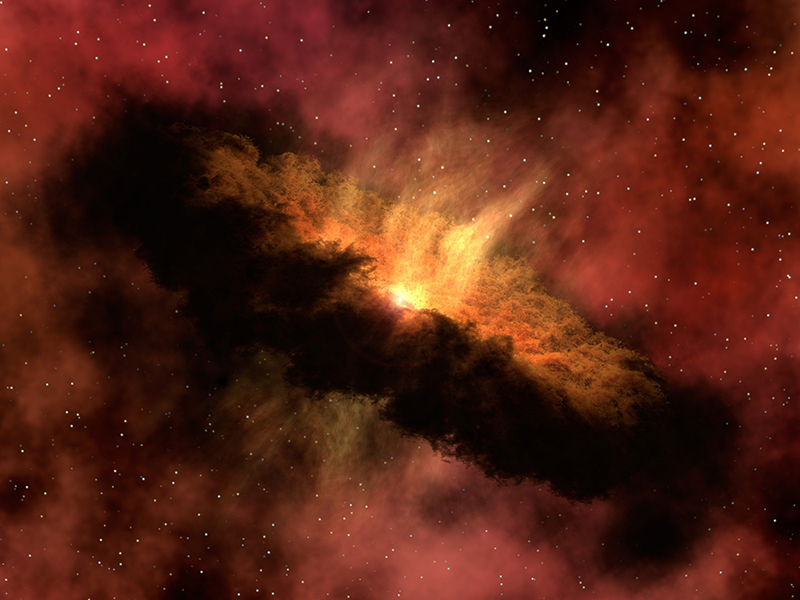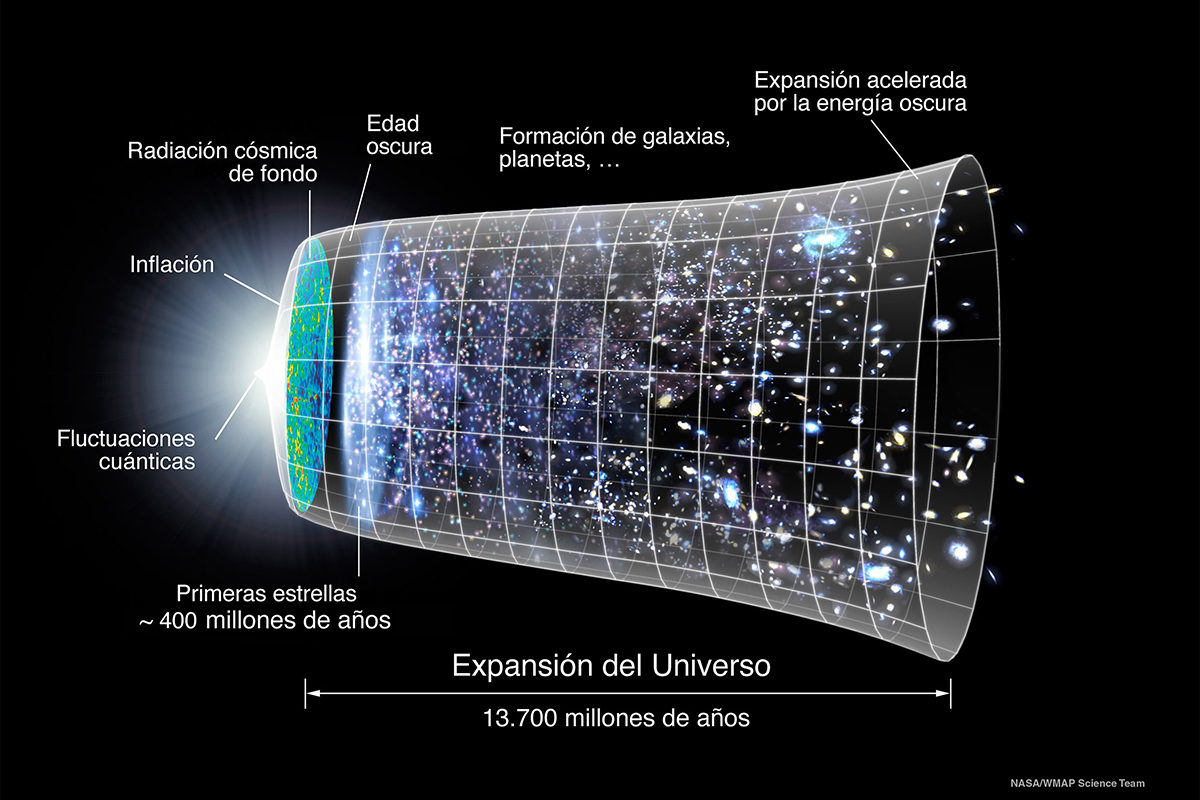The Big Bang theory, in its simplest form, tells us that about 13.8 billion years ago the beginning of space and time as we know them occurred and that everything arose from a singularity, that is, an infinitely hot spot. and infinitely dense where the laws of physics do not apply.
From this "explosion" the Universe expands immensely rapidly, and a series of processes occur which are described below, chronologically, and which are referenced in the image on the side, from the beginning of the Universe to the present day.
Moment from which the laws of physics as we know them begin to operate, since between 0 and 10-43 seconds there were no elementary particles and the 4 fundamental forces were united (10-43 seconds is what is called a Planck time, the smallest period that can be measured by physics; the time it takes a photon traveling at the speed of light to traverse a Planck length).

What existed before the Planck Era cannot be explained by the laws of physics and remains in unknown territory, at least until a Unifying Theory of the 4 fundamental forces is harmonized, one of the greatest challenges in physics.
This is the name given to a moment in which, after the Planck Era, gravity is separated from the other fundamental forces, leaving only the weak nuclear interaction, strong nuclear interaction and electromagnetism. Here additional processes ensued. First, a very rapid expansion of space took place and then the first elementary particles (quarks, electrons, neutrinos) began to form, which were followed by baryonic matter (such as the neutron and proton), matter that today is superior to non-baryonic.
The Universe still occupies a small space, at a high density and pressure and temperature (1027 K), where particles and molecules cannot yet join together under such conditions.
At the beginning of this era (10-35 to 10-10 seconds), the strong nuclear force separated from the electroweak force, releasing an enormous amount of energy and triggering a sudden and rapid expansion known as inflation. As space expanded faster than the speed of light, various energetic interactions created elementary particles such as photons, gluons, quarks, W and Z bosons, and Higgs bosons. This era ended with the separation of electromagnetism and the weak nuclear force once the Universe expanded and cooled sufficiently.
During this period, a soup of particles filled the Universe (quarks-antiquarks, electrons-positrons, as well as other particle-antiparticle pairs exchanged mass for energy through matter-antimatter collisions. The Universe cooled to such an extent that it led to a process of "annihilation", either by a slight asymmetry in quantity (or behavior) of the particles or a slight excess of particles over antiparticles, all antiquarks were annihilated and only quarks remained, so that matter would predominate over antimatter.
During this period, protons and neutrons combined to form the first atomic nuclei of hydrogen, some of which went on to fuse into helium and lithium; the environment remained dense, so the nuclei split apart again as soon as they formed. This fusion and splitting process continued until ~3 minutes after the Big Bang, when the Universe cooled enough (109 K) for fusion to end. But the temperature remained high enough to keep the particles ionized until about 380,000~500,000 years after the Big Bang (Nuclear Age). At this point, 75% of the baryonic matter was in the form of hydrogen, 25% in the form of helium, and traces of other elements.
The age of atoms followed the age of nuclei, where free electrons joined ionized particles (through a process called recombination) to form neutral atoms, as the Universe continued to cool enough (3000 K) for nuclei to capture these electrons. Photons (particles of light) were no longer affected by matter after the formation of atoms (radiation was no longer trapped), becoming free to move in space (creating the cosmic microwave background).
Thus the Universe became composed of neutral atoms and photons that now produce light. Matter now becomes transparent to visible light for the first time.
During this time, which spans up to the present day, the process of creation of stars and galaxies took place, formed from atoms. In this timeline, the force of gravity causes matter to begin to interact to form galaxies, a process that continues even today. And these galaxies have been formed as a product of the birth of stars, which arose from areas with greater gas density in the expanding Universe. These stars grouped together, giving rise to galaxies. The oldest are the elliptical and lenticular ones, and they are also the most massive in the Universe (even 100 times the mass of the Milky Way).
In all this path, the Solar System began about 9,000 million years ago after the Big Bang, when a cloud of gas that came from several ancient generations would condense to form the star that is today our Sun. That is why it was speaks of ours as a late generation star.
The Sun is currently halfway through its life, and the entire Universe can now be said to be halfway through its existence, considering the various proposed destinations for the end of the Universe as we know it, such as the Big Crunch, Big Rip or Big Freeze.

If the Universe has enough mass to continue expanding indefinitely, we are dealing with a flat Universe that will always remain in equilibrium with gravity. Thus, the expansion will have no limit, objects will move further and further apart, and space will continue to cool down. If, on the other hand, gravity is greater than the expansion, we are dealing with a closed Universe that will eventually begin to contract, reaching a point called the Big Crunch. And if the expansion exceeds gravity, we are dealing with an open Universe that would eventually tear the Universe apart, in an event known as the Big Rip. Let's look at this scenario.
This theory, also known as the "Big Crunch", is one of the possible fates considered for the end of the Universe, based on certain conditions. The Big Crunch is an estimate based on the Universe being closed, that is, exceeding a critical density (expressed as >1) where gravity ends up superimposing the expansion force, causing it to slowly slow down until it begins to contract, increasing the temperature and proximity between astronomical objects.
A closed Universe would counteract the repulsive action of dark energy, which is why this fate (like the others) depends on the amount of dark energy that exists. In a hypothetical Big Crunch, the entire Universe would collapse at a point (a singularity), just like the one that gave rise to the Big Bang.
This theory, also known as the "Big Rip", is a possible fate for the end of the Universe based on it being open, that is, negatively curved and failing to exceed a critical density (expressed as >1), where the repulsive action of dark energy ends up superimposing gravity, and therefore accelerating the expansion of the Universe until gravity can no longer hold structures together, first separating galaxies and then crushing stars.
Everything would be reduced to elementary particles and radiation incapable of cohering again, constituting a singularity. If this scenario takes place, it has been estimated that it would occur within about 20 billion years.
This theory, also known as "Big Freeze«, is the third possible destination for the end of the Universe, based on it being flat geometry, that is, that there is an equivalence between gravity and the speed of expansion of the Universe and that the critical density is not exceeded (expressed as ![]() =1). In this scenario, as both effects are counteracted, the expansion would expand continuously but in a decelerated manner, although without ever reaching zero (asymptotically).
=1). In this scenario, as both effects are counteracted, the expansion would expand continuously but in a decelerated manner, although without ever reaching zero (asymptotically).
Because this would expand the Universe more and more, objects would move further apart and the surrounding space would continue to cool down, so much so that it would no longer have enough energy to sustain life, nor generate more reactions to produce structures such as new stars. This would trigger a "thermal death» of the Universe, but without a collapse event as such occurring.


